Tropical pewee has been split into three species:
- Northern tropical pewee, Contopus bogotensis
- Southern tropical pewee, Contopus cinereus
- Tumbes pewee, Contopus punensis
Tropical pewee has been split into three species:

The eastern wood pewee is a small tyrant flycatcher from North America. This bird and the western wood pewee were formerly considered a single species. The two species are virtually identical in appearance, and can be distinguished most easily by their calls.

The western wood pewee is a small tyrant flycatcher. Adults are gray-olive on the upperparts with light underparts, washed with olive on the breast. They have two wing bars and a dark bill with yellow at the base of the lower mandible. This bird is very similar in appearance to the eastern wood pewee; the two birds were formerly considered to be one species. The call of C. sordidulus is a loud buzzy peeer; the song consists of three rapid descending tsees ending with a descending peeer.

The olive-sided flycatcher is a small to medium sized passerine bird in the family Tyrannidae, the Tyrant flycatcher family. It is a migratory species that travels from South to North America to breed during the summer. It is a very agile flyer and mainly consumes flying insects on flight. Since 2016, this species has been assessed as being near-threatened globally (IUCN) and threatened in Canada (SRA) due to its declining populations.
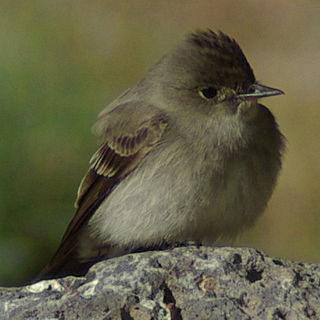
The pewees are a genus, Contopus, of small to medium-sized insect-eating birds in the Tyrant flycatcher family Tyrannidae.

The southern tropical pewee is a small passerine bird in the tyrant flycatcher family. It breeds from southern Brazil and Paraguay south to Argentina.

The dark pewee is a small passerine bird in the tyrant flycatcher family. It is endemic to the Talamancan montane forests of Costa Rica and western Panama.

The greater pewee is a passerine and is in the tyrant flycatcher group. This species' range is further north than the other Mexican species. This bird was formerly known as Coues' flycatcher.

The white-throated pewee is a species of bird in the family Tyrannidae. It is found in Brazil, French Guiana, and Suriname. Its natural habitat is subtropical or tropical moist lowland forests.

The Cuban pewee or crescent-eyed pewee is a species of bird in the family Tyrannidae. It is found in Cuba and the northern Bahamas. It was formerly lumped with the Hispaniolan pewee and Jamaican pewee as a single species, the Greater Antillean pewee.

The smoke-colored pewee is a species of bird in the family Tyrannidae. The species is characterized by a uniform dusky-grey plumage.
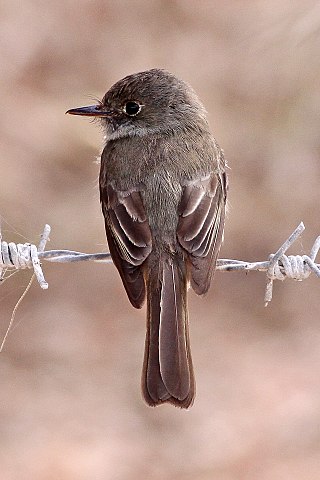
The Hispaniolan pewee is a species of bird in the Tyrannidae (flycatcher) family. It is endemic to the island of Hispaniola in the Caribbean.
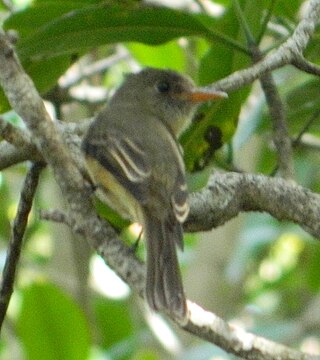
The Lesser Antillean pewee is a species of bird in the family Tyrannidae.
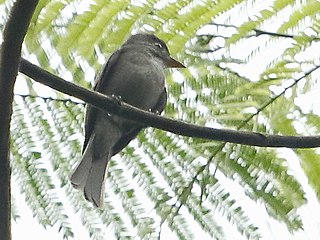
The blackish pewee is a species of bird in the family Tyrannidae. It is found in Brazil, Ecuador, Guyana, and Peru.

The ochraceous pewee is a species of bird in the family Tyrannidae. It is found in Costa Rica and western Panama. Its natural habitat is subtropical or tropical moist montane forests.

The Jamaican pewee is a species of bird in the family Tyrannidae. It is endemic to Jamaica. It was formerly regarded as a subspecies of the Greater Antillean pewee.
The Greater Antillean pewee has been split into three species:
Wood pewee or peewee may refer to the following species formerly considered to be a single species:
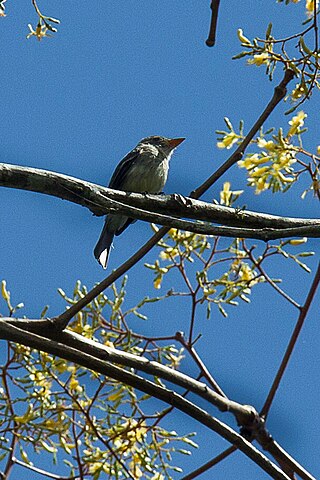
The Tumbes pewee or western tropical pewee is a passerine bird in the family Tyrannidae formerly thought to be conspecific with the tropical pewee. It is endemic to western Ecuador and western Peru.

The northern tropical pewee is a species of bird in the family Tyrannidae. It is found in southeastern Mexico to northern South America from northern Colombia to northeastern Brazil. Its natural habitat is subtropical or tropical moist montane forests.